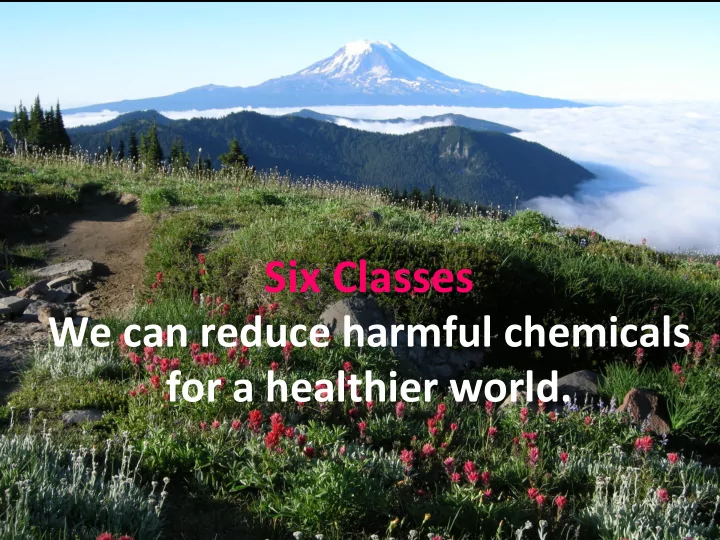

¡ Six ¡Classes ¡ ¡ We ¡can ¡reduce ¡harmful ¡chemicals ¡ for ¡a ¡healthier ¡world. ¡ ¡ ¡
Periodic ¡table ¡of ¡elements ¡ 2 ¡
Six ¡classes ¡ 9 ¡ 1. Per-‑ ¡and ¡polyfluorinated ¡substances ¡ ¡ F ¡ stain ¡and ¡water ¡repellants ¡ ¡ 2. Chlorinated ¡an?microbials ¡ 17 ¡ Cl ¡ triclosan ¡and ¡triclocarban ¡ 3. Flame ¡retardants ¡ ¡ 35 ¡ PBDEs, ¡Tris, ¡Firemaster, ¡etc ¡ Br ¡ 3 ¡
Six ¡classes ¡ 1. Per ¡and ¡polyfluorinated ¡ ¡chemicals ¡ ¡ ¡ ¡ ¡ ¡ ¡ ¡ stain ¡and ¡water ¡repellants ¡ ¡ 2. Chlorinated ¡an?microbials ¡ triclosan ¡and ¡triclocarban ¡ 3. Flame ¡retardants ¡ ¡ PBDEs, ¡Tris, ¡Firemaster, ¡etc ¡ 4. Endocrine ¡disrup?ng ¡plas?cizers ¡ ¡ BPA, ¡phthalates, ¡etc. ¡ 5. Some ¡solvents ¡ ¡ benzene, ¡toluene, ¡xylene, ¡etc. ¡ ¡ 6. Some ¡heavy ¡metals ¡ ¡ lead, ¡mercury, ¡chromium, ¡cadmium, ¡etc. ¡ 4 ¡
Six ¡Classes ¡ ¡ 1. ¡Highly ¡Fluorinated ¡Chemicals ¡ (Fluorochemicals) ¡ ¡ ¡ ¡ ¡ ¡ Dr. ¡Jennifer ¡A. ¡Field ¡ ¡ Department ¡of ¡Environmental ¡and ¡Molecular ¡Toxicology ¡ Oregon ¡State ¡University ¡ Corvallis, ¡Oregon ¡97331 ¡ 5 ¡
Chemical ¡Personality ¡and ¡C-‑F ¡bonds ¡ ¡ • Atoms ¡share ¡electrons ¡in ¡the ¡form ¡of ¡bonds ¡that ¡glue ¡molecules ¡ together ¡ • C-‑F ¡bonds ¡are ¡the ¡strongest ¡bonds ¡in ¡nature ¡ ¡ • Unique ¡properNes ¡ • oil ¡and ¡water ¡repellency ¡ ¡ • resistance ¡to ¡breakdown ¡in ¡the ¡environment ¡and ¡under ¡ harsh ¡condiNons ¡ PFOA ¡ PFOS ¡ 6 ¡
Fluorochemicals ¡ ¡ • Do ¡not ¡occur ¡in ¡nature; ¡only ¡due ¡to ¡manufacture, ¡ use, ¡and ¡disposal ¡ • C8 ¡forms ¡(PFOS ¡and ¡PFOA) ¡are ¡of ¡parNcular ¡interest ¡ • Produced ¡in ¡large ¡quanNNes ¡since ¡1940s ¡ • Well ¡studied ¡ • Associated ¡with ¡wide ¡range ¡of ¡human ¡health ¡ problems ¡ • C4/C6 ¡produced ¡since ¡the ¡1940s ¡and ¡share ¡family ¡ structure ¡and ¡properNes, ¡but ¡almost ¡no ¡informaNon ¡ on ¡health ¡effects ¡ 7 ¡
Where ¡Fluorochemicals ¡are ¡Used ¡ • CarpeNng ¡ ¡ • Upholstery ¡ • Apparel ¡ • Waxes ¡(ski ¡and ¡floor) ¡ • Food ¡packaging ¡materials ¡ • Non-‑sNck ¡cookware ¡ • Dental ¡floss ¡ 8 ¡
Pathways ¡to ¡the ¡Environment ¡ ¡ Indoor ¡and ¡Outdoor ¡Air ¡ ¡ • Semi-‑volaNle ¡forms ¡migrate ¡out ¡from ¡products ¡ • Higher ¡indoor ¡air ¡concentraNons ¡move ¡outdoors ¡ ¡ Surface ¡and ¡Ground ¡Water ¡ • Industrial ¡discharge ¡ • Wash-‑off ¡from ¡treated ¡apparel ¡ ¡ • Wastewater ¡treatment ¡does ¡not ¡remove ¡PFOS/ PFOA ¡or ¡shorter-‑chain ¡analogs ¡ ¡ ¡ Solid ¡Waste ¡Disposal ¡ • Treated ¡materials ¡sent ¡to ¡landfills ¡ • Liquid ¡waste ¡(leachates) ¡sent ¡to ¡wastewater ¡ treatment ¡plants ¡or ¡percolate ¡into ¡ground ¡ ¡ 9 ¡
Sources ¡and ¡Exposure ¡Pathways ¡ breastmilk dust/fibre goods cord blood Prenatal/infant Human exposure exposure PFAS producers/ PFAS-using factories manufacturer waste solid Landfill leachate WWTP liquid 10 ¡ Adapted from Oliaei 2013, Environ Pollut Res
Found ¡Globally ¡Today ¡ • Surface ¡Waters ¡ ¡(lakes, ¡rivers, ¡ocean) ¡ • Sediments ¡& ¡soils ¡ • Groundwater ¡(drinking ¡water ¡source) ¡ ¡ • Air, ¡Rain, ¡Snow ¡in ¡urban ¡and ¡remote ¡locaNons ¡ ¡ • Marine ¡and ¡land-‑based ¡wildlife ¡ ¡ 11 ¡
Human ¡Toxicology ¡ • PFOS ¡and ¡PFOA ¡persist ¡in ¡the ¡body ¡for ¡years ¡ ¡ • Health ¡effects ¡linked ¡to ¡exposure ¡to ¡PFOA: ¡ ¡ • Kidney, ¡prostate, ¡ovarian, ¡and ¡tesNcular ¡cancer ¡ ¡ • Thyroid ¡disease ¡ • Delayed ¡puberty, ¡decreased ¡ferNlity ¡(women) ¡ ¡ ¡ ¡ ¡ ¡and ¡early ¡menopause ¡ • Reduced ¡testosterone ¡levels ¡ • Reduced ¡immune ¡response ¡in ¡children ¡ ¡ • Elevated ¡cholesterol ¡ 12 ¡
PFOS ¡and ¡PFOA ¡Replacements ¡ • Shorter ¡chains ¡(C4/C6) ¡offered ¡as ¡‘alternaNves’ ¡but ¡are ¡ members ¡of ¡the ¡PFOS/PFOA ¡families ¡or ¡close ¡cousins ¡ ¡ • C4/C6 ¡now ¡found ¡in ¡surface ¡waters, ¡groundwater, ¡ wastewater, ¡& ¡seawater ¡ ¡ • ¡ ¡ ¡ ¡C4/C6 ¡not ¡bioaccumulaNve ¡but ¡ ¡ ¡are ¡persistent, ¡which ¡is ¡a ¡‘family ¡trait’ ¡ • ¡ ¡ ¡ ¡Very ¡limited ¡toxicology ¡data ¡on ¡ ¡ ¡short ¡chain ¡(C4/C6) ¡family ¡members ¡ -‑ ¡ ¡ ¡ Increasing ¡C6 ¡levels ¡in ¡human ¡blood ¡ -‑ ¡ ¡ ¡ Causes ¡changes ¡in ¡cells ¡associated ¡ ¡ ¡ ¡ ¡ ¡ ¡with ¡tumors 13 ¡
Take ¡Home ¡Points ¡ • Once ¡produced, ¡fluorochemicals ¡stay ¡on ¡the ¡planet ¡ for ¡a ¡very, ¡very ¡long ¡Nme. ¡ • Widespread ¡contaminaNon ¡of ¡water, ¡food, ¡and ¡ soils; ¡distributed ¡globally ¡by ¡air ¡and ¡water ¡ circulaNon. ¡ • Current ¡understanding ¡of ¡human ¡health ¡effects ¡ developed ¡for ¡only ¡PFOS ¡& ¡PFOA. ¡ • Changing ¡to ¡other ¡forms ¡such ¡as ¡C6 ¡and ¡C4 ¡may ¡ appear ¡as ¡a ¡quick ¡fix ¡for ¡the ¡marketplace ¡but ¡there ¡ is ¡no ¡data ¡to ¡show ¡they ¡are ¡safer. ¡ 14 ¡
What ¡can ¡we ¡do ¡to ¡reduce ¡harm? ¡ • Do ¡we ¡need ¡them ¡for ¡performance/protecNon ¡in ¡all ¡ current ¡applicaNons? ¡ – Apparel ¡ – CarpeNng ¡ ¡ ¡ – Food ¡packaging ¡ ¡ ¡ • Support ¡research ¡to ¡find ¡safer ¡alternaNves ¡ – Materials ¡innovaNon ¡taking ¡a ¡page ¡from ¡nature ¡ (bio-‑mimicry) ¡ – Green ¡chemistry ¡ ¡ 15 ¡
Follow-‑up ¡ques?ons ¡ ¡ – Are ¡there ¡fluorochemicals ¡in ¡the ¡products ¡you ¡ manufacture, ¡sell, ¡or ¡use? ¡ – What ¡funcNons ¡do ¡they ¡serve? ¡ – How ¡necessary ¡are ¡these ¡funcNons? ¡ – What ¡alternaNves ¡have ¡you ¡invesNgated? ¡ ¡ – Would ¡you ¡be ¡interested ¡in ¡conNnuing ¡this ¡ discussion? ¡ If ¡so, ¡contact: ¡ ¡ info@GreenSciencePolicy.org ¡ ¡ 16 ¡
Recommend
More recommend